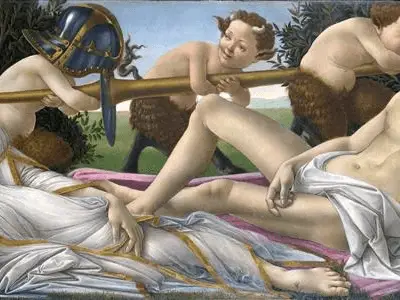Title of Artwork: “Venus and Mars”

Artwork by Sandro Botticelli
Year Created 1483
Summary of Venus and Mars
About 1485, the Italian Renaissance painter Sandro Botticelli created a panel painting entitled Venus and Mars (or Venus and Mars). Allegorically, it depicts the Roman deities Venus (goddess of love) and Mars (goddess of war). In the midst of a forest full of frolicking baby satyrs, a young and sensual couple reclines on a log.
All About Venus and Mars
The picture was probably made as a part of a set to decorate the bedroom of the bride and groom after their wedding, placed inside panelling or a piece of furniture. The large format and up-close perspective of the figurines suggest this.
As a symbol of sensual love, it is commonly regarded as an ideal. Poliziano, the Medici house poet and Renaissance Humanist scholar, is likely to have been an advisor to Botticelli when he came up with the subject for the painting.
It has been decided to use the “c. 1485” dating that was given by the National Gallery in 2017. However, according to Lightbown, it is “probably approximately 1483,” while Ettlingers believe it was built in the later half of the fourteenth century.
In order to determine a date, one must analyse the painting’s style, which hasn’t been proven to be linked to a specific event (such as the wedding). It follows the Primavera and Pallas and the Centaur (both around 1482) and is around the time of The Birth of Venus (c. 1486).
The National Gallery in London has owned this artwork since 1874, making it the only one not housed in Florence’s Uffizi Gallery.
The satyrs toy with Mars’ helmet (a sallet) and lance while a third rests in his breastplate under his arm while Venus watches Mars sleep. A fourth tries in vain to wake him up by blowing into his ear with a little conch shell.
Men falling asleep after sex was a frequent topic of ribald jokes at Renaissance Italian weddings, and it is safe to assume that the pair has been having sex. The lance and conch might be seen as sexual symbols.
For this scene, the setting is amid a forest of myrtle or laurel, which is historically connected with Venus and marriage or perhaps both plants. In the distance, you can make out a walled city in the distance.
There is a wasps’ nest near Mars’ head in the foreground, which may represent the fact that love often brings agony. Ernst Gombrich first proposed the theory that the wasps represent the Vespucci family, who may have commissioned the painting, in a letter to the artist.
He and his family had known one other since childhood and in 1480, they commissioned Botticelli’s St. Augustine in His Study for the Ognissanti cathedral in Florence, Italy.
They had wasps on their coat of arms since their name translates to “tiny wasps” in Italian, and the wasps’ nest, located in a cavity in the tree in the panel’s upper left corner, is exactly where patrons’ coats of arms were commonly painted.
Information Citations
En.wikipedia.org, https://en.wikipedia.org/.























